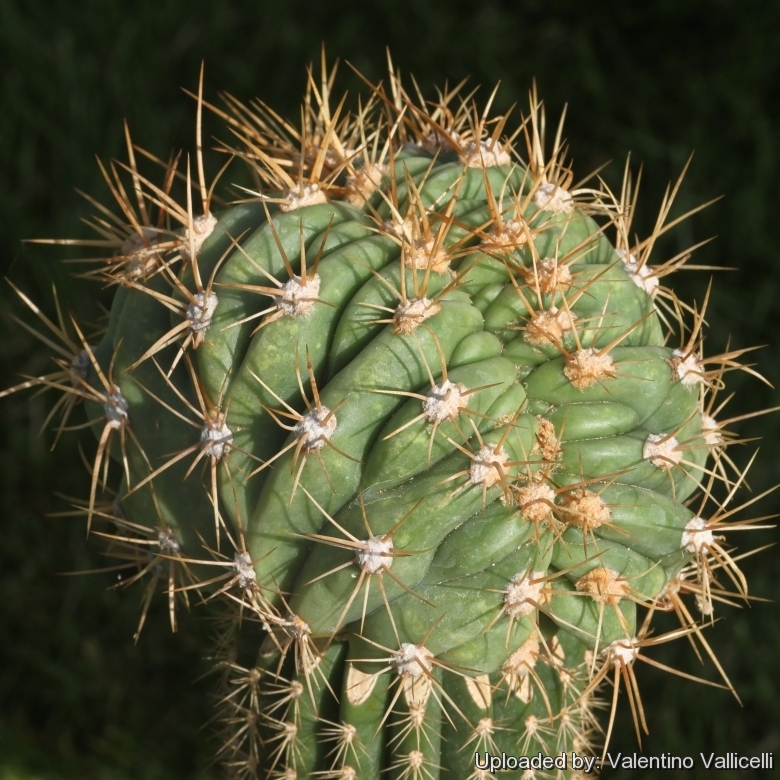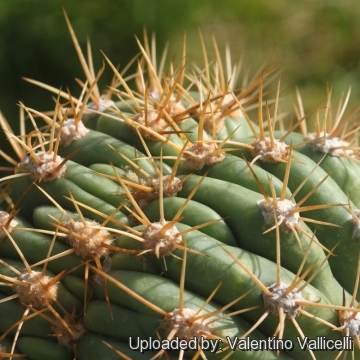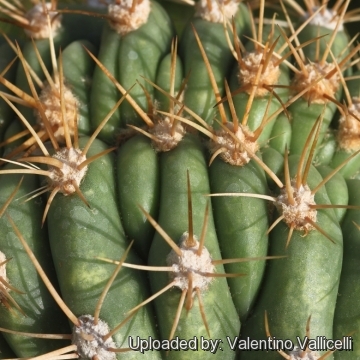Accepted Scientific Name: Echinopsis atacamensis subs. pasacana f. cristata hort.

Trichocereus pasacana f. cristatus (Echinopsis atacamensis subs. pasacana f. cristata) Photo by: Valentino Vallicelli
Origin and Habitat: Garden origin (Nursery produced cultivar)
Synonyms:
See all synonyms of Echinopsis atacamensis
Description: The typical Echinopsis atacamensisSN|7374]]SN|7374]] subsp. pasacana is a massive tall tree-like cactus (commonly known as the "Pasacana Cactus " or “Cardón Grande”) with a strong branched habit. It is popular and grown for the huge stem that stays for a long time solitary but produces lateral branches and becomes Saguaro-like with age. The crested form can also get very big making a spectacular specimen.
Stem: Pale green and heavily ribbed with numerous areoles sprouting radial, yellow-brown spines.
Ribs: Deep and Rounded.
Areoles: creamy to brownish becoming large, round that produce at once a whole spine cluster, but the areoles remain capable of further growth. Many years later new spines may be formed from the upper part of the areoles.
Spines: 30-50, unequal, hardly distinguishable from radials to central, subulate, rigid, yellow-brown, the longest up to 15 (or more) cm long, but usually less than 10 cm long.
Flowers: Not known.
Fruit: Not known.
Subspecies, varieties, forms and cultivars of plants belonging to the Echinopsis atacamensis group
Notes: The cause of cresting is not fully explained; biologists disagree as to why some plants grow in this unusual form. Some speculate that it is a genetic mutation. Others say it is the result of lightning strike or freeze damage, but whatever the stimulus, the growth point of the stem has switched from a geometric point, to a line, which folds and undulates as the crest expands. Though these crested Pasacanas are somewhat rare (about 1 in 250,000), cresting occurs naturally throughout its range, and can be encountered in many other cactus species.
In the ontogenesis a crest can appear any time, but development of crests on large columnar cactus species (such as the Trichocereus pasacanaSN|6864]]SN|6864]]) in the early stages of ontogenesis is unlikely. On the other hand, small species may crest early already at the cotyledons stage.
Bibliography: Major references and further lectures
1) Anderson, Edward F. (2001), "The Cactus Family" Pentland, Oregon: Timber Press, ISBN 978-0-88192-498-5
2) Curt Backeberg “Cactus Lexicon” Sterling Publishing Company, Incorporated, 1978
3) Keith Grantham, Paul Klaassen “The plantfinder's guide to cacti & other succulents” Timber Press, 18/mag/1999
4) Britton & Rose "The Cactaceae" 4: 273, 1923
5) Hiroshi Hirao “Colour encyclopaedia of cacti” Japan 1979 (Japanese language and script)
6) Willy Cullmann, Erich Götz (Dozent Dr.), Gerhard Gröner “The encyclopedia of cacti” Portland, OR: Timber Press, 1986
7) David Hunt, Nigel Taylor “The New Cactus Lexicon” DH Books, 2006 ISBN 0953813444, 9780953813445
8) Theodore H. Fleming, Alfonso Valiente Banuet “Columnar Cacti and Their Mutualists: Evolution, Ecology, and Conservation” University of Arizona Press, 2002
 Trichocereus pasacana f. cristatus (Echinopsis atacamensis subs. pasacana f. cristata) Photo by: Valentino Vallicelli
Trichocereus pasacana f. cristatus (Echinopsis atacamensis subs. pasacana f. cristata) Photo by: Valentino Vallicelli Trichocereus pasacana f. cristatus (Echinopsis atacamensis subs. pasacana f. cristata) Photo by: Valentino Vallicelli
Trichocereus pasacana f. cristatus (Echinopsis atacamensis subs. pasacana f. cristata) Photo by: Valentino VallicelliCultivation and Propagation: The crests are frequently grafted onto a stron Trichoceresu trunk but are also cultivable on their own roots.
It grow slowly and are
Soil: They need a well drained soil mix, with small gravel added to ensure drainage.
Water: Water regularly in summer but allow to dry fully before watering again. During the winter months they should be rather kept dry, and water is restricted to only enough to keep the stems and branches from shrivelling.
Exposure: Light shade when young, full sun later.
Hardiness: They are moderately cold hardy, an can wistand to light frees down to -5° C or less for very short times, but make sure that they are not exposed to severe freezing temperatures, or they may die. Nevertheless it is good advice never let the night-time temperature fall below 5°C.
Manteinance: Since they are big-sized plants, they need plenty of space for their roots. Repotting should be done every other year, or when the plant has outgrown its pot.
Propagation: This plant, like other clonal cultivars, may be only propagated vegetatively from stem cuttings in spring (let them dry till the ends callous well. Then replant them in fresh cactus soil that is ever so slightly moist, and keep it that way till they root) or by grafting onto a very strong columnar cactus.













